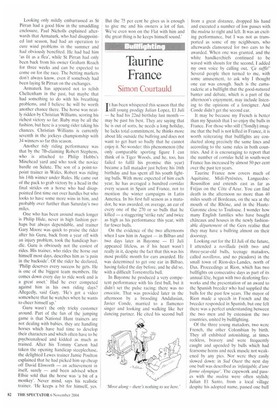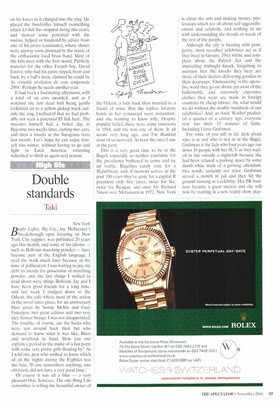Bullfighting
Taurine France
Simon Courtauld
It has been whispered this season that the still young prodigy Julian Lopez, El Juli — he had his 22nd birthday last month — may be past his best. They are saying that he is out of sorts, he needs a long holiday, he lacks total commitment, he thinks more about life outside the bullring and does not want to get hurt so badly that he cannot enjoy it. No wonder: this phenomenon (the only comparable sporting figure I can think of is Tiger Woods, and he, too, has failed to fulfil his promise this year) became a full matador just before his 16th birthday and has spent all his youth fighting bulls. With more expected of him each year. he has averaged a hundred con-idas every season in Spain and France, not to mention the winter campaigns in Latin America. In his first full season as a matador, he was awarded, on average, an ear of every one of the 270 or so bulls that he killed — a staggering 'strike rate' and twice as high as his performance this year, with far fewer bulls.
On the evidence of the two afternoons when I saw him in August — in Bilbao and two days later in Bayonne — El Juli appeared lifeless, as if his heart wasn't really in it, despite the fact that this was his most prolific month for ears awarded. He was determined to get one ear in Bilbao, having failed the day before, and he did so, with a difficult Torrestrella bull.
In Bayonne he produced a very competent performance with his first bull, but it didn't set the pulse racing; there was no emocion. That was provided later in the afternoon by a brooding Andalusian, Javier Conde, married to a flamenco singer and looking and walking like her dancing partner. He cited his second bull from a great distance, dropped his hand and executed a number of low passes with the muleta to right and left. It was an exciting performance, but I was not as transported as some of my neighbours, who afterwards clamoured for two cars to be awarded. When one was granted, and the white handkerchiefs continued to be waved with shouts for the second, I added my own voice by calling out, 'cif sujfir Several people then turned to me, with some amusement, to ask why I thought one ear was enough. Such is the camaraderie at a bullfight that the good-natured banter and debate, which is a part of the afternoon's enjoyment, may include listening to the opinions of a foreigner. And Conde didn't get the second ear.
It may be because my French is better than my Spanish that I so enjoy the bulls in France. For those who still (?fondly) imagine that the bull is not killed in France, it is worth reiterating that bullfights are conducted along precisely the same lines and according to the same rules in both countries. And it is encouraging to report that the number of comdas held in south-west France has increased by almost 50 per cent over the past ten years.
Taurine France now covers much of Aquitaine, Midi-Pyrenees, LanguedocRoussillon and extends east as far as Frejus on the C6te d'Azur. You can find death in the afternoon no more than 40 miles south of Bordeaux, on the sea at the mouth of the RhOne, and in the HauteGaronne close to Toulouse. I wonder how many English families who have bought châteaux and houses in the newly fashionable departement of the Gers realise that they may have a bullring almost on their doorstep.
Looking out for the El Juli of the future, I attended a novillada (with twoand three-year-old bulls, teenage matadors, called novilleros, and no picadors) in the small town of Rion-des-Landes, north of Dax. Proceedings at Rion, which has two bullfights on consecutive days as part of its annual fête, began with two deafening fireworks and the presentation of an award to the Spanish breeder who had supplied the bulls for the past few years. The mayor of Rion made a speech in French and the breeder responded in Spanish, but one felt there was a perfect understanding between the two men and by extension the two countries, united by bullfighting.
Of the three young matadors, two were French, the other Colombian by birth. They all exhibited astonishing, at times reckless, bravery and were frequently caught and upended by bulls which had fearsome horns and neck muscle not weakened by any pies. Nor were they easily slowed down: in Sud Ouest the next day one bull was described as infatigable, d'une forme olympique'. The capework and passes with the muleta were often stylish; Julian El Santo, from a local village despite his adopted name, passed one bull on his knees as it charged into the ring. He placed the banderillas himself (something which El Juli has stopped doing this year), and showed some potential with the mu/eta, helped or hindered by advice from one of his peons (assistants), whose shouts were anyway soon drowned by the music of the enthusiastic local brass hand. Most of the kills were with the first sword. Publicity material for the other French boy, David Esteve, who had his pants ripped, front and back, by a bull's horn, claimed he could be ?a veritable revelation de cette temporada 2004'. Perhaps he needs another year.
It had been a fascinating afternoon, with a total of six ears awarded, and as watched the last dead bull being gently forklifted on to a yellow pickup truck outside the ring, I reflected that we had probably not seen a potential El hill here. The maestro himself had a better day in Bayonne two weeks later, cutting two ears, and then a Muni.° at the Saragossa feria last month. Let's hope he can enjoy himself this winter, without having to go and fight in Latin America, returning refreshed to thrill us again next season.



























































































































 Previous page
Previous page